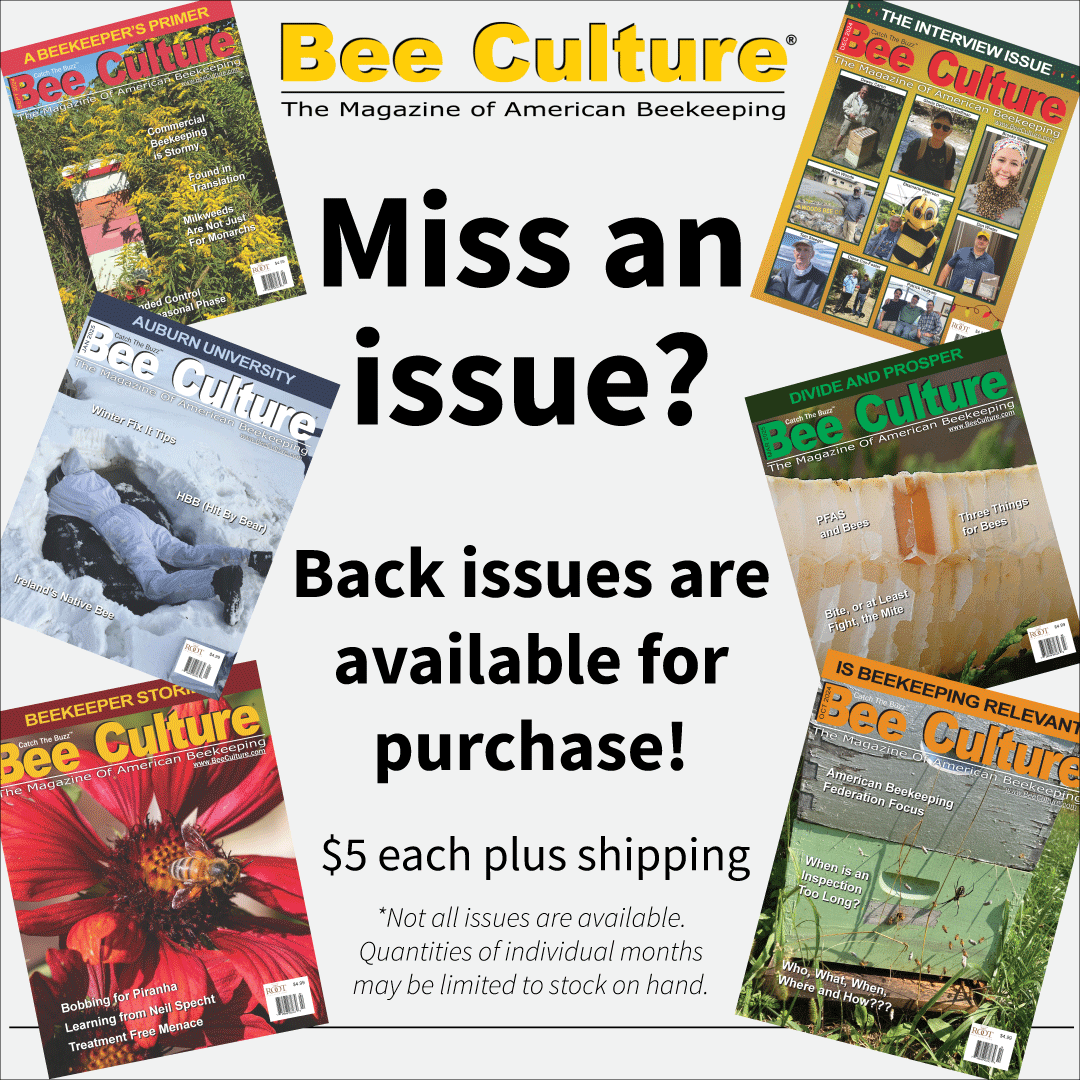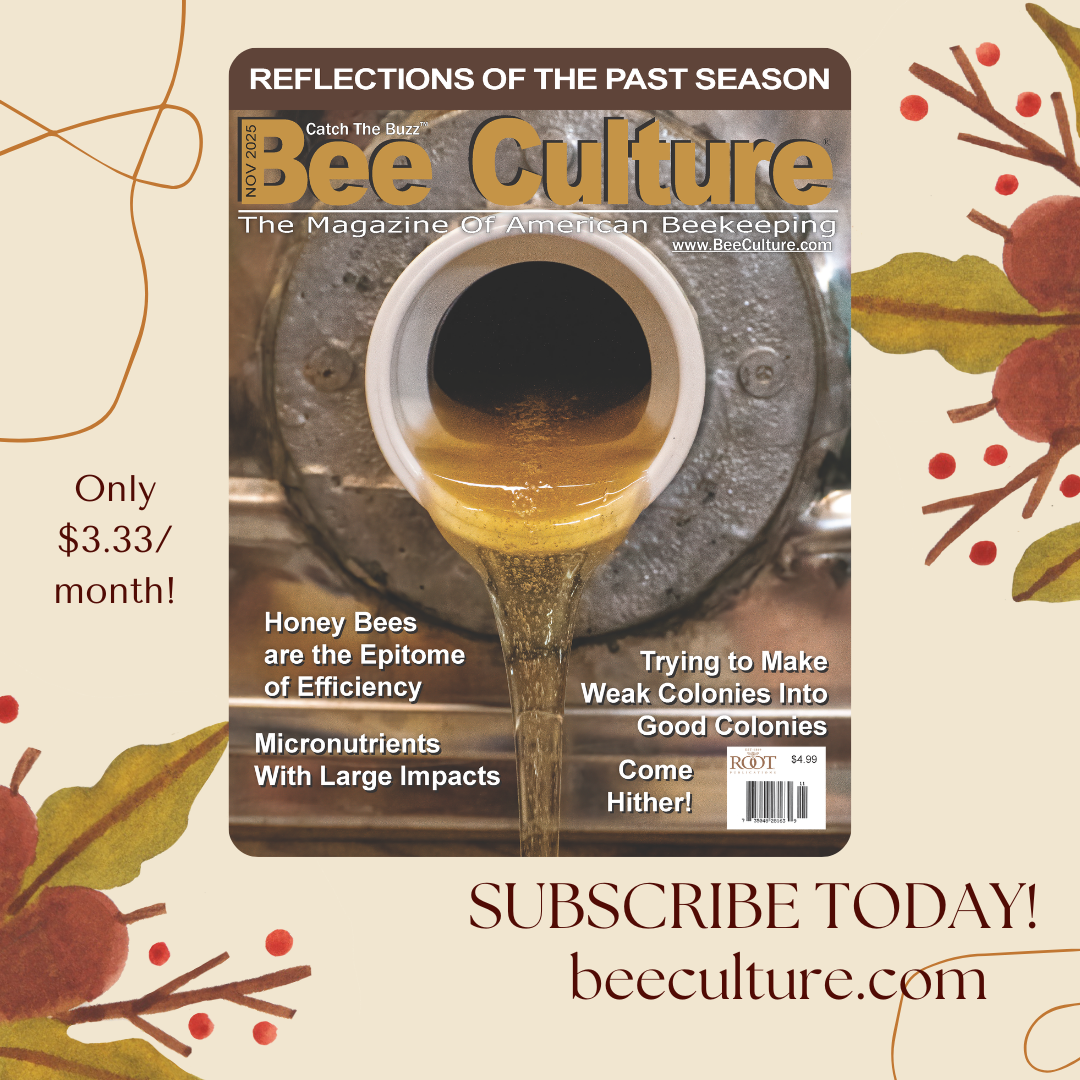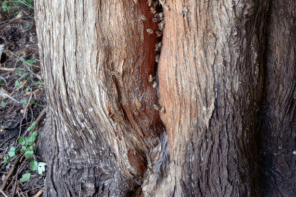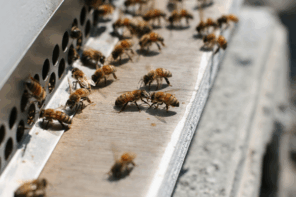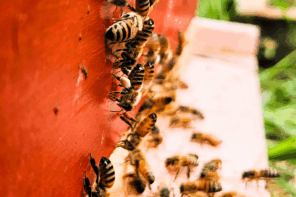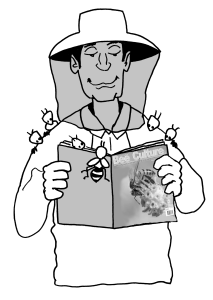 From the Editor
From the Editor
RNAi For Varroa Control
Q – After reading the item from GreenLight in your August issue, I’ve tried to find more information on the RNAi mite control. Looks like GreenLight purchased the technology from Bayer. I am hopeful that you (as the editor of BC) have contacted them and can share more information about this treatment (like where it is in testing/approval) in the September issue. Thanks! David LeGrys
A – Hey David,
Might want to google up Jerry Hayes, RNAi, Monsanto, Wired magazine. Take care. Jerry
Jerry, thank you for this directed path to the Wired magazine article. I really felt I got to know you and was amazed at your dedication to bees as a Florida bee inspector, then working within the system at Monsanto to try and help bees, helping to set up the Honey Bee Health Coalition and now as editor of BC. Thank you. I wish every BC subscriber would read this article.
I assume that the large field trial did not go so well, perhaps hard to get the nurse bees to eat the syrup and get it in the baby bees. The Greenlight article in the August BC was so positive. I am terrified of a time of amitraz resistance. Here in central NC the temperatures are too hot to use (following the label) some of the organic options at the times we need to work on mite control.
Something like RNAi, with no mite resistance, in sugar syrup sounds like the answer to a prayer.
Thanks again. David
A – Your first sentence, second paragraph is spot on.
Greenlights goal is to ‘make’ more of the RNAi faster and cheaper and elevate the active quantity in a dose to raise the potential of more RNAi getting to the food fed to the developing larvae. The real delivery is when the foundress mother mite submerges herself in the larval food to hide in this new cell. She has to take a couple gulps of the food which gives her the nutrition to be able to lay eggs when cell is capped and she emerges. If more RNAi is in the food delivered by Nurse Bees and is still active in syrup after three days in theory it should be effective on the foundress mite.
The above is a gamble for Greenlight.
Jerry
Metarhizium For Varroa Control
Q – Do you recommend using the fungus metarhizium on a hobby bee hive if so how much?
Thanks, Curt
A – Short answer is no. One, it has not gone through the ‘Regulatory’ process to allow it to be sold and used with appropriate label directions.
Longer answer is that years ago I was involved in approved research field trials using metarhizium to control Varroa. Picture this, you spread these fungus spores onto honey bees in a honey bee colony hoping they get on a Varroa mite. You have immediately introduced ‘trash’ into the colony and the bees hygienic behavior gets geared up to clean this stuff up and out and remove it from the colony. Let’s say most of it is removed by the bees but some does get on a Varroa mite and it stays there. At the time the strain we were testing had temperature and humidity requirements that the interior of a honey bee colony sometimes met and sometimes didn’t for the fungus to grow. Sometimes it did stay on Varroa and grow and its mycelium would get into the Varroa mite and kill, hurt, damage it. But, most of the time it didn’t stay, grow and control Varroa consistently. Soooo, the research project was dropped.
Fast forward to 2021. Maybe there is a better more adapted metarhizium but you may still have delivery, temperature. and humidity issues.
Jerry
Weak Hive
Q – I have a hive with only two frames of bees with scattered brood. I can’t find a queen. Should I requeen or add frames to another hive? Thank you. Mr Johnson
A – Probably time to combine this with a strong colony. Winter is coming and two frames is not enough of a good start.
Jerry
Oxalic Acid Vapor Treatment
Q – Jerry, my first question I would like to ask is about an oxalic dribble/drizzle. I understand that that is not effective when brood is present. You referred to damaging the bees/colony.
What are your thoughts on doing a treatment around the end of December when little or no brood is present in my location? Thanks, Eddie
A – Northern European beekeepers have been using one treatment oxalic acid ‘trickling/dribbling for a long time successfully by application when there is little or no brood present. That means most of Varroa is exposed and one treatment means the bees and the Queen experience less collateral damage from the Acid. Vaporization can be used but please only once as there is more collateral damage to the colony with multiple vaporization applications. Dribbling is cheaper and easier. Jerry
Eddie, thanks for the quick response. We have some members of our club who do an oxalic vapor treatment every week for three or four weeks during the Summer. I can’t believe that the queen is not damaged by this. Eddie
Jerry, let’s say you have a parasite on you the size of a rat Eddie. You can’t get it off and I can’t help you get it off either. So we come up with a plan. I’ll lock you in your closet and we will vaporize a caustic acid in the closet with you. We do it. I open the door and the parasite the size of a rat has fallen off. Good deal. But you have burns on your skin, you nasal passages are burned along with your trachea from breathing this stuff in. Some of your eyebrow hairs are burned off and your eyes are red and watering because of acid burn.
This is what is happening to a colony of honey bees with multiple applications of Oxalic Acid. Workers may only have a short life span but the Queen gets hit every time. Honey Bees communicate with a variety of pheromones, kairomone odors. The honey bees nose is at the tip of their antenna. With multiple Oxalic Acid vaporizations these get burned and the bees can’t smell. They can’t communicate and that is why there is Queen supercedure so often because the bees can’t smell if there is a Queen or brood or danger or . . .
And Oxalic Acid when it comes in contact with Calcium cause it to leach out. That is why humans who are exposed to Oxalic Acid sometimes get kidney stones. Honey bee larvae have lots of calcium in them as well as adult honey bees.
It just isn’t a good idea. And when the colony dies over winter the beekeeper blames something or somebody else.
I am stepping away from the microphone now:) Jerry
Replacing Old Comb
Q – I lost all nine hives, primarily due to “Covid neglect” – Varroa and starvation, not disease. I am making lemonade from these sour lemons, taking advantage of emptied equipment to clean, repair, paint, etc. It seems like a good idea to get on board with the three to five year comb replacement plan as well. Do I clean the wooden frames and scrape off the old wax off the plastic foundation, replace the plastic foundation in the current frames, or scrap the whole thing and start new? If one of the latter two, what do I do with all that plastic?! Catherine
A – It’s humbling isn’t it? Which in 2021 isn’t a bad thing for all of us.
In old brood comb the residue of chemicals, bacteria, virus and combinations thereof are in the dark brood comb. The ‘dark’ is a buildup of larval skins as the developing larva molts many times and those that follow in the same cell. The darker the more larval skins, the more potential ‘residues’ are there
If you have embossed plastic foundation scrape off all the old comb the best you can. And scrape any thing off the wooden frame as well. If you have access to CLEAN beeswax you can melt it in a double boiler and using a paint brush or one of those small paint rollers recoat the foundation. It encourages the bees to build more comb but it also covers over any old comb residue you couldn’t scrape off.
It should be fine. And if you take out two combs every year and do the re-work you stay ahead of the game and not all at once.
Please go to the Honey Bee Health Coalition, ‘Tools for Varroa Management Guide’, memorize it and pick out your control options and do it. https://honeybeehealthcoalition.org/wp-content/uploads/2015/08/HBHC-Guide_Varroa-Interactive-PDF.pdf. Jerry
When Do Swarms Start
Q – Hi Jerry, I miss not having you doing “The Classroom.” Happily, Jamie Ellis is doing a good job. I suppose because you taught him everything he knows about beekeeping. 🙂
Although you are no longer doing “The Classroom” for the American Bee Journal, I have a question that perhaps you are the one to answer. Some years ago I read in the ABJ that one could expect the swarming season to start a certain number of days (or was it weeks?) after dandelions started to bloom. However, I don’t remember just how many days it was that you (if it was you) said. Could you please enlighten me as to how long the time is?
Regarding another issue, I once asked you whether to use two-pound packages or three-pound packages. You answered that one should use three-pound packages. In the back of my mind I thought I had once read something different. Recently I was rereading an old article “Productive Management of Honey-Bee Colonies” by C.L. Farrar which was published in the ABJ, Vol, 108, Nos.3-10, 1968. I quote from the article, “The two-pound package supporting a good queen will develop a full strength colony in practically the same time as a larger package when drawn combs, pollen, and honey can be supplied.” I suppose I didn’t make it clear that I was able to install my packages into hives that I now know satisfy Farrar’s conditions. In my case, a local commercial beekeeper sold me some two-pound packages for a price I couldn’t turn down.
I want you to know that after my best friend and mentor Dave Noetzel passed away, I turned to you for beekeeping information. I greatly appreciate your help. Thank you so much. God bless you, Joe Schultz
A – Nice to hear from you and for the compliment. Jamie is a lot smarter than I am:)
Nothing in Beekeeping is solid to hang on to. Certainly generalities but in the age of Varroa, all generalities are false. If somebody said that it was X days after dandelions bloom that swarms emerge that is highly variable and not true. When Spring in general starts then of course nectar and pollen and weather interact to encourage colonies to grow and prepare to spread their genetics (swarming) while they in parallel prepare for winter. And these all have different calendar dates depending if you are in Georgia or Minnesota or Arizona or Idaho. Honey Bees are always preparing for a temperate Winter.
The key is not just dandelions, its all early pollinator friendly flowers along with day length, temperature, pollen and nectar from any source in amounts that encourage brood rearing.
I still vote for a three-lb package if the price is right and the package has lots of young bees. Simply because in Spring more bees are better than fewer bees for brood rearing, internal temperature control, foraging for pollen and nectar, etc. Of course, a two-lb Package will work it just takes X time longer. All the best to you. Stay safe and well. Jerry


